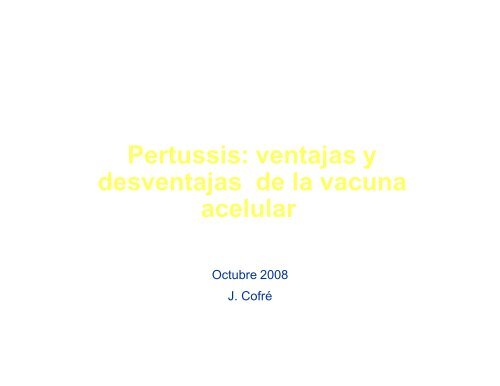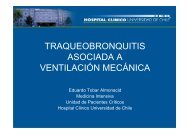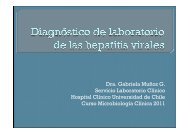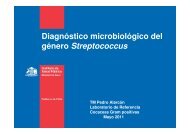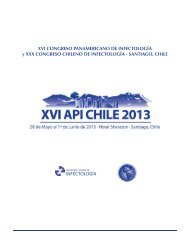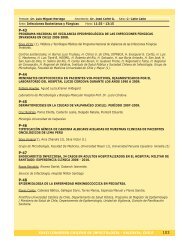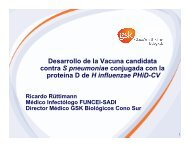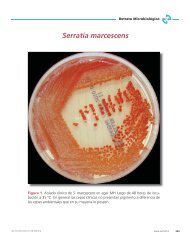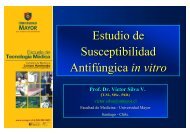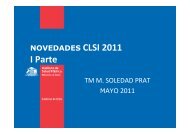Pertussis: ventajas y desventajas de la vacuna acelular
Pertussis: ventajas y desventajas de la vacuna acelular
Pertussis: ventajas y desventajas de la vacuna acelular
Create successful ePaper yourself
Turn your PDF publications into a flip-book with our unique Google optimized e-Paper software.
<strong>Pertussis</strong>: <strong>ventajas</strong> y<br />
<strong>de</strong>s<strong>ventajas</strong> <strong>de</strong> <strong>la</strong> <strong>vacuna</strong><br />
acelu<strong>la</strong>r<br />
Octubre 2008<br />
J. Cofré
Vacunas pertussis: acelu<strong>la</strong>r vs “celu<strong>la</strong>r”<br />
Ventajas<br />
Antígenos purificados<br />
Mayor consistencia<br />
entre lotes<br />
Menor reactogenicidad<br />
local y general<br />
Amplio límite <strong>de</strong> edad<br />
Des<strong>ventajas</strong><br />
Eficacia <strong>de</strong>pen<strong>de</strong> <strong>de</strong><br />
composición: óptimo 3-<br />
5 antígenos)<br />
Primo<strong>vacuna</strong>ción:<br />
combinada (5-6<br />
<strong>vacuna</strong>s) en <strong>la</strong>ctantes<br />
Mayor costo
Ranking personal <strong>de</strong> <strong>vacuna</strong>s<br />
• Green Cross 1954<br />
<strong>vacuna</strong> pertussi
Algo <strong>de</strong> historia<br />
•<br />
• 1920: primeras <strong>vacuna</strong>s anti pertussis (“celu<strong>la</strong>res”)<br />
• 1940-50: uso sistemático en niños<br />
• 1991: primera <strong>vacuna</strong> acelu<strong>la</strong>r (Pa): indicada para refuerzo a los<br />
18 meses y 4 % 6 años<br />
• 1996: Pa: indicada como primo<strong>vacuna</strong>ción<br />
• <strong>de</strong>l <strong>la</strong>ctante < 12 meses<br />
• 2005: dTpa licenciada para adolescentes y adultos<br />
• 2006: ACIP recomienda <strong>vacuna</strong>r con dTPa a personal <strong>de</strong> <strong>la</strong><br />
salud en riesgo
KM Bisgard y cols. Pediatrics agosto 2005
WHO Working Group on standardisation and control of acellu<strong>la</strong>r<br />
pertussis vaccines—Report of a meeting held on 16%17March 2006,<br />
St. Albans, United Kingdom<br />
Acellu<strong>la</strong>r pertussis vaccines had been introduced<br />
against a background of a variety of formu<strong>la</strong>tions with<br />
no globally agreed standard and with no generally<br />
accepted animal mo<strong>de</strong>l for potency assessment.<br />
Vaccine 2007 (25): 2749%57
Problemas<br />
• Múltiples productos:<br />
% múltiples antígenos<br />
% múltiples concentraciones <strong>de</strong> antígenos<br />
% múltiples combinaciones con otras <strong>vacuna</strong>s<br />
• Ausencia <strong>de</strong> estándares <strong>de</strong>:<br />
% e<strong>la</strong>boración (purificación <strong>de</strong> antígenos, <strong>de</strong>toxicación)<br />
% pruebas <strong>de</strong> equivalencia entre productos<br />
% Corre<strong>la</strong>tos <strong>de</strong> potencia<br />
% Pruebas <strong>de</strong> control <strong>de</strong> toxicidad<br />
% Corre<strong>la</strong>tos <strong>de</strong> protección<br />
Vaccine 2007; 25: 2749-57
Vacunas anti-pertussis acelu<strong>la</strong>res licenciadas para uso en <strong>la</strong>ctantes<br />
Vacuna - Marca - Fabricante<br />
DTPa1 Certiva ®<br />
DTPa2 - GSK<br />
DTPa3 Acelluvac ®<br />
DTPa3 Infanrix Hexa ®<br />
DTPa4 Acel Immune ®<br />
DTPa5 Daptacel ®<br />
Baxter<br />
DTPa2 Tripedia ® Sanofi P<br />
DTPa2 Triaxim ® Sanofi P<br />
Novartis<br />
GSK<br />
Wyeth-T<br />
Sanofi P<br />
DTPa5 Pediacel ® Sanofi P<br />
Pentaxim ®<br />
PT<br />
40<br />
23,4<br />
25<br />
25<br />
5<br />
25<br />
3,5<br />
10<br />
20<br />
Antígeno (µg)<br />
FHA PRN Fimbrias 2-3<br />
23,4 - -<br />
25 - -<br />
25<br />
2,5 2,5 -<br />
25 8 -<br />
35 2 0,8 FIM 2<br />
5 3 5<br />
20 3 5<br />
PT: pertusinógeno. FHA: hemaglutinina fi<strong>la</strong>mentosa. PRN: pertactina<br />
Adaptado <strong>de</strong> K. Edwards y M. Decker en Plotkin-Orenstein: Vaccines 2004 4th ed.
Eficacia <strong>de</strong> <strong>vacuna</strong>s anti-pertussis acelu<strong>la</strong>res en<br />
<strong>la</strong>ctantes, según número <strong>de</strong> antígenos incluidos<br />
JT Poolman et al. Exp Rev Vaccines 2007; 6(1): 47-56
Eficacia comparativa <strong>de</strong> <strong>vacuna</strong>s anti-pertussis<br />
“enteras” vs acelu<strong>la</strong>res en <strong>la</strong>ctantes<br />
• Resultados son heterogéneos<br />
• Vacunas con 3 y 5 Ags son > eficaces que <strong>vacuna</strong>s<br />
celu<strong>la</strong>res (sg. <strong>de</strong>finición OMS.)<br />
• Algunas <strong>vacuna</strong>s celu<strong>la</strong>res superan en eficacia a <strong>vacuna</strong>s<br />
acelu<strong>la</strong>res con 3 Ags<br />
• Vacunas acelu<strong>la</strong>res con 2 y 4 Ags < eficacia que <strong>vacuna</strong>s<br />
celu<strong>la</strong>res (sg. <strong>de</strong>finición OMS.)<br />
• Vacunas celu<strong>la</strong>res > eficacia contra enfermedad leve que<br />
acelu<strong>la</strong>res con 2-4 Ags e igua<strong>la</strong>n a <strong>la</strong>s con 5 Ags
Eficacia (vs p<strong>la</strong>cebo) <strong>de</strong> <strong>vacuna</strong>s antipertussis<br />
“enteras” y acelu<strong>la</strong>res<br />
Según <strong>de</strong>finición<br />
OMS<br />
Máxima<br />
Vacunas enteras<br />
92% (RR 0,08)<br />
Vacunas<br />
acelu<strong>la</strong>res<br />
67-70%<br />
(1 -2 comp.)<br />
80-84%<br />
(3-5 comp.)<br />
Mínima<br />
Coqueluche leve<br />
46% (RR 0,54)<br />
37%<br />
67-70%<br />
(3-5 comp.)<br />
42% (2 comp.)<br />
70-71% (3 comp.)<br />
76% (5 comp.)<br />
T. Jefferson et al. Vaccine 2003; 21: 2003-14
Casos <strong>de</strong> coqueluche confirmada* en Suecia.<br />
Enero 1986-diciembre 2000<br />
* RPC o cultivo P. Olin et al. Vaccine 2003; 21: 2015-21
Duración <strong>de</strong> inmunidad conferida por <strong>la</strong> infección<br />
natural, <strong>vacuna</strong> “celu<strong>la</strong>r” y acelu<strong>la</strong>r*<br />
Infección natural<br />
Duración <strong>de</strong> <strong>la</strong><br />
inmunidad: años<br />
(rango)<br />
7-10 a 20<br />
Referencias<br />
CH. Wirsing von König. Lancet 1995<br />
E. Miller et al. Dev Biol Stand 1997<br />
H. Broutin et al. Vaccine 2004<br />
Vacuna “celu<strong>la</strong>r”<br />
6-9<br />
(4-12)<br />
S. Torvaldsen, PB. McIntyre. PIDJ 2003<br />
HJ Lambert et al. Public Health Rep 1965<br />
D. Jenkinson. BMJ (Clin Res) 1988<br />
Vacuna acelu<strong>la</strong>r<br />
5,5-6<br />
S. Salmaso et al. Pediatrics 2001<br />
Y. Tindberg et al. PIDJ 1999<br />
S. Lugauer et al. Eur J Pediatr 2002<br />
* sesgo: B. pertussis aún circu<strong>la</strong> en <strong>la</strong> comunidad<br />
Adaptado <strong>de</strong> AM Wen<strong>de</strong>lboe et al. PIDJ 2005; 24: S58-61
¿Qué componentes <strong>de</strong>biera tener una<br />
<strong>vacuna</strong> acelu<strong>la</strong>r anti-pertussis?<br />
• Variaciones antigénicas en cepas<br />
circu<strong>la</strong>ntes no afectan su eficacia:<br />
% PT: necesario<br />
% FHA: necesario<br />
% PRN: conveniente<br />
• Discutible importancia <strong>de</strong> variaciones<br />
antigénicas <strong>de</strong> cepas circu<strong>la</strong>ntes<br />
% Fimbrias 2-3: amplían eficacia
Seguridad comparativa <strong>de</strong> <strong>vacuna</strong>s “celu<strong>la</strong>res” y acelu<strong>la</strong>res<br />
Efecto adverso<br />
Vacuna<br />
Celulitis*<br />
OR<br />
Fiebre*<br />
> 38ºC<br />
OR<br />
Fiebre*<br />
> 39ºC<br />
OR<br />
Convulsiones**<br />
OR<br />
S. Hipotónicohiporeactividad**<br />
OR<br />
DTaP3 vs<br />
DTP<br />
(n aprox: 12.000<br />
vs 6.000)<br />
0,15<br />
0,07<br />
0,09<br />
0,17<br />
0,31<br />
DTaP5 vs<br />
DTP<br />
(n aprox: 20.000<br />
vs 20.000)<br />
0,21<br />
0,03<br />
0,18<br />
-<br />
0,52<br />
* Una dosis ** tres dosis T. Jefferson et al. Vaccine 2003; 21: 2003-14
Recomendaciones ACIP<br />
• Poner en <strong>la</strong> ba<strong>la</strong>nza <strong>la</strong> administración <strong>de</strong><br />
<strong>vacuna</strong>s DTP y DTaP vs riesgo <strong>de</strong> <strong>la</strong><br />
enfermedad en niños que han presentado<br />
los siguientes efectos con dosis previa <strong>de</strong><br />
<strong>vacuna</strong>:<br />
% Fiebre >40,5ºC, l<strong>la</strong>nto persistente (> 3 horas),<br />
shock hipotónico-hiporreactivo, convulsiones<br />
antes <strong>de</strong> 3 días<br />
MMWR 2006; Mar 24, vol 55 RR 3: 1-35
Nuevos grupos a <strong>vacuna</strong>r contra<br />
pertussis
Composición <strong>de</strong> <strong>vacuna</strong>s anti-pertussis acelu<strong>la</strong>res<br />
utilizables en adolescentes y adultos<br />
Antígeno<br />
Toxoi<strong>de</strong> diftérico Lf<br />
Toxoi<strong>de</strong> tetánico Lf<br />
Pertusinógeno (µg)<br />
Hemaglutinina<br />
fi<strong>la</strong>mentosa (µg)<br />
Pertactina (µg)<br />
Fimbrias 2 -3 (µg)<br />
Al(OH) 3 (mg)<br />
Boostrix ®<br />
GSK<br />
2,5<br />
5<br />
8<br />
8<br />
2,5<br />
-<br />
Composición comparativa <strong>de</strong> <strong>vacuna</strong>s acelu<strong>la</strong>res<br />
utilizadas en <strong>la</strong>ctantes vs adolescentes y adultos<br />
Antígeno<br />
DTPa<br />
Infanrix ®<br />
GSK<br />
dTpa<br />
Boostrix ®<br />
GSK<br />
Toxoi<strong>de</strong> diftérico Lf<br />
Toxoi<strong>de</strong> tetánico Lf<br />
Pertusinógeno (µg)<br />
Hemaglutinina<br />
fi<strong>la</strong>mentosa (µg)<br />
Pertactina (µg)<br />
Al(OH) 3 (mg)<br />
25<br />
10<br />
25<br />
25<br />
8<br />
0,5<br />
2,5<br />
5<br />
8<br />
8<br />
2,5<br />
< 0,39 - 0,5
Inmunogenicidad comparativa (medias geométricas) <strong>de</strong><br />
<strong>vacuna</strong> acelu<strong>la</strong>r utilizada en adolescentes vs <strong>la</strong>ctantes<br />
Anticuerpos<br />
Anti-Pertusinógeno<br />
Anti-Hemaglutinina<br />
fi<strong>la</strong>mentosa<br />
Anti-Pertactina<br />
Razón BOOSTRIX ®<br />
/INFANRIX ® (IC 95%) 1<br />
1,9 (1,8-2,0)<br />
7,4 (6,9-7,9)<br />
4,2 (3,7-4,7)<br />
1 adolescentes a un mes <strong>de</strong> recibir dTpa (BOOSTRIX®) en comparación<br />
con 3 dosis <strong>de</strong> DTPa (INFANRIX ® ) en <strong>la</strong>ctantes
Inmunogenicidad comparativa (medias geométricas) <strong>de</strong><br />
<strong>vacuna</strong> acelu<strong>la</strong>r utilizada en adolescentes y adultos vs<br />
<strong>la</strong>ctantes<br />
Anticuerpos<br />
Razón ADACEL ® /<br />
DAPTACEL ® (IC 95%) 1<br />
Anti-Pertusinógeno<br />
Anti-Hemaglutinina<br />
fi<strong>la</strong>mentosa<br />
Anti-Pertactina<br />
3,6 (2,8-4,5)<br />
5,4 (4,5-6,5)<br />
3,2 (2,5-4,1)<br />
Anti-Fimbrias 2-3<br />
5,3 (3,9-7,1)<br />
1 adolescentes a un mes <strong>de</strong> recibir dTpa (ADACEL®) en comparación<br />
con 3 dosis <strong>de</strong> DTPa (DAPTACEL ® ) en <strong>la</strong>ctantes
Inmunogenicidad comparativa (MG) <strong>de</strong> 3 dosis <strong>de</strong> <strong>vacuna</strong><br />
DTPa (<strong>la</strong>ctantes <strong>de</strong> 7 meses) vs 1 dosis <strong>de</strong> dTpa<br />
(adolescentes)<br />
Adaptado <strong>de</strong> BioDrugs 2006; 20(2): 371-89
Eficacia <strong>de</strong> <strong>vacuna</strong>s acelu<strong>la</strong>res en adultos y<br />
adolescentes<br />
• 1997: el Vaccines and Re<strong>la</strong>ted Biological<br />
Products Advisory Committee acuerda<br />
aceptar como criterio <strong>de</strong> eficacia para<br />
estos grupos etarios:<br />
• “una seroconversión equivalente a <strong>la</strong><br />
observada en <strong>la</strong>ctantes durante protocolos<br />
<strong>de</strong> evaluación <strong>de</strong> eficacia”
Eficacia <strong>de</strong> <strong>vacuna</strong> antipertussis acelu<strong>la</strong>r en<br />
adolescentes y adultos<br />
• N: 2.781 sujetos (15-64 años)<br />
• pa trivalente (= BOOSTRIX ® ) comparativo con<br />
<strong>vacuna</strong> anti-hepatitis A (Havrix ®)<br />
• Definición <strong>de</strong> caso: tos > 5 días + cultivo, RPC<br />
(+), o seroconversión<br />
• Seguimiento 2 ½ años<br />
• Casos: 1 en <strong>vacuna</strong>dos, 9 en grupo control<br />
• Eficacia: 92% (IC95%: 32-99%)<br />
JI Ward y cols. N Engl J Med 2005; 353: 1555-63
Seguridad <strong>de</strong> <strong>vacuna</strong> dTpa en adultos.<br />
Efectos generales. 1<br />
1 Vacuna con 5 componentes. Sanofi-Pasteur MMWR 2006; Dec 15, vol 55 RR 17: 1-37
Seguridad <strong>de</strong> <strong>vacuna</strong> dTpa en adultos.<br />
Efectos locales. 1<br />
1 Vacuna con 5 componentes. Sanofi-Pasteur MMWR 2006; Dec 15, vol 55 RR 17: 1-37
Recomendaciones ACIP<br />
• Fomentar <strong>la</strong> <strong>vacuna</strong>ción periódica <strong>de</strong><br />
adultos con dTpa en reemp<strong>la</strong>zo <strong>de</strong> dT<br />
• Re<strong>vacuna</strong>r cada 10 años.<br />
•<br />
• Si existe riesgo epi<strong>de</strong>miológico <strong>de</strong><br />
contagio/transmisión a <strong>la</strong>ctantes, p<strong>la</strong>zo<br />
pue<strong>de</strong> ser tan breve como 2 años <strong>de</strong>spués<br />
<strong>de</strong> dosis pre-existente <strong>de</strong> dT<br />
MMWR 2006; Dec 15, vol 55 RR 17: 1-37
Recomendaciones ACIP<br />
• Focalizar los esfuerzos <strong>de</strong> inmunizar<br />
adultos en torno a neonatos y <strong>la</strong>ctantes,<br />
<strong>vacuna</strong>ndo:<br />
% mujeres en edad fértil “en campaña”<br />
% puérperas<br />
% padres jóvenes<br />
% abuelos (edad límite 65 años)<br />
% guardadoras y personal <strong>de</strong> salud en servicios<br />
pediátricos<br />
MMWR 2006; Dec 15, vol 55 RR 17: 1-37
Celulitis extensa en <strong>la</strong> extremidad puncionada y dosis<br />
múltiples <strong>de</strong> <strong>vacuna</strong>s acelu<strong>la</strong>res en niños.Reporte al VAERS<br />
años 1990-2003<br />
Vacuna<br />
DTPa<br />
DTP<br />
PTPH<br />
HB<br />
DT<br />
HiB<br />
< 2 años<br />
(n <strong>de</strong> reportes: 64)<br />
26,6 %<br />
26,6 %<br />
23,4 %<br />
6,3 %<br />
6,3 %<br />
2-7 años<br />
(n <strong>de</strong> reportes: 92)<br />
54,3 %<br />
25,0 %<br />
3,3 %<br />
-<br />
3,3%<br />
-<br />
EJ Woo y cols. CID 2003; 37: 351-8
Reactogenicidad comparativa <strong>de</strong> <strong>vacuna</strong>s DTaP y dTap en<br />
niños <strong>de</strong> 4-6 años<br />
JM Langley et al. Vaccine 2007; 25: 1121-5
Aspectos no resueltos con <strong>vacuna</strong>s<br />
acelu<strong>la</strong>res. Apreciación personal.<br />
• Impacto en <strong>la</strong> colonización (portación<br />
transitoria <strong>de</strong> B. pertussis)<br />
% Niños <strong>vacuna</strong>dos ¿son potenciales<br />
contagiantes si se exponen a caso índice?<br />
% CDC aún recomienda QP ante <strong>la</strong> exposición en<br />
personal <strong>de</strong> salud <strong>vacuna</strong>do
Aspectos no resueltos con <strong>vacuna</strong>s<br />
acelu<strong>la</strong>res. Apreciación personal.<br />
• Inmunogenicidad y seguridad en <strong>la</strong> 3ª<br />
edad<br />
• Seguridad <strong>de</strong> <strong>la</strong> <strong>vacuna</strong> en mujeres<br />
embarazadas<br />
• Vacunación en embarazo: ¿afecta R<br />
inmune en <strong>la</strong>ctantes a DTaP?<br />
• Duración <strong>de</strong> <strong>la</strong> inmunidad en adultos:<br />
¿re<strong>vacuna</strong>r?<br />
• Seguridad <strong>de</strong> <strong>la</strong> re<strong>vacuna</strong>ción en adultos
Aspectos no resueltos con <strong>vacuna</strong>s antipertussis:<br />
Comprobación <strong>de</strong> su capacidad para lograr<br />
el control estable <strong>de</strong> <strong>la</strong> infección y<br />
enfermedad causada por B. pertussis, en<br />
todas sus formas, en una comunidad que ha<br />
sido <strong>vacuna</strong>da en forma universal
Vacunas pertussis: acelu<strong>la</strong>r vs “celu<strong>la</strong>r”<br />
Ventajas<br />
Antígenos purificados<br />
Mayor consistencia<br />
entre lotes<br />
Menor reactogenicidad<br />
local y general<br />
Amplio límite <strong>de</strong> edad<br />
Des<strong>ventajas</strong><br />
Eficacia <strong>de</strong>pen<strong>de</strong> <strong>de</strong><br />
composición: óptimo 3-<br />
5 antígenos)<br />
Primo<strong>vacuna</strong>ción:<br />
combinada (5-6<br />
<strong>vacuna</strong>s) en <strong>la</strong>ctantes<br />
Mayor costo


